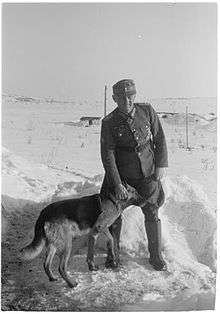Georg Ritter von Hengl
Georg Ritter von Hengl (21 October 1897 – 19 March 1952) was a general in the Wehrmacht of Nazi Germany during World War II who commanded the XIX Mountain Corps. He was a recipient of the Knight's Cross of the Iron Cross.
Georg Ritter von Hengl | |
|---|---|
 Hengel at Petsamo. | |
| Born | 21 October 1897 Lailing |
| Died | 19 March 1952 (aged 54) Sonthofen |
| Allegiance | |
| Service/ | Waffen SS Heer |
| Years of service | 1914–1921 1934–1945 |
| Rank | Obersturmbannführer (SS) General der Gebirgstruppe (Heer) |
| Commands held | 2. Gebirgs-Division XIX. Gebirgs-Armeekorps |
| Battles/wars | World War I World War II |
| Awards | Knight's Cross of the Iron Cross |
| Other work | Police Officer |
During World War I, he had served in the Luftstreitkrafte and shot down a total of 7 aircraft between July and October 1918. From 1921 to 1934, he also served in the German police, reaching the rank of Hauptmann. Georg Ritter von Hengl was captured by Allied troops in May 1945 and was released in 1947.
World War I service
Hengl served initially in Reserve Infantry Battalion Nr. 21 near Ypres in 1914. The following year saw him transferred to the Eastern Front to serve in Russia. In October 1915, he was transferred south to the Serbian sector. He transferred back to France in 1916, to serve near Verdun; on 23 March he was promoted into the officer's ranks as a Leutnant. He then returned to duties in Russia. After requesting a transfer to aviation duty, he started aerial observer's training on 23 February 1918. Upon graduation, he was posted to the Kingdom of Bavaria's FA(A) 295. His usual pilot in the two-seater reconnaissance aircraft was Johann Baur. The duo were credited with six confirmed aerial victories together, beginning with a double victory over SPADs on 17 July 1918 over Courton Wood. The aircrew of Hengl and Baur were shot down behind British lines during the Third Battle of the Aisne; however, they were rescued from captivity by troopers from Württemberg. The pair would score another four victories in October 1918, with Hengl scoring a seventh while crewing for another pilot. [1]
Georg Hengl emerged from World War I having been awarded both classes of the Iron Cross and the Royal House Order of Hohenzollern. His native Kingdom of Bavaria also bestowed the Military Order of Max Joseph upon him;[1] one of the entitlements of this decoration was an award of lifetime nobility for him, signified by the addition of the phrase "Ritter von" to one's name. Georg Hengl thus became George Ritter von Hengl.[2]
Awards and decorations
- Knight's Cross of the Iron Cross on 25 August 1941 as Oberstleutnant and commander of Gebirgsjäger-Regiment 137.[3]
References
Citations
- Franks et al 1993, p. 127.
- The Aerodrome website page on the Max Joseph http://www.theaerodrome.com/aces/germany/hengl.php Retrieved 16 February 2013.
- Fellgiebel 2000, p. 183.
Bibliography
- Fellgiebel, Walther-Peer (2000) [1986]. Die Träger des Ritterkreuzes des Eisernen Kreuzes 1939–1945 — Die Inhaber der höchsten Auszeichnung des Zweiten Weltkrieges aller Wehrmachtteile [The Bearers of the Knight's Cross of the Iron Cross 1939–1945 — The Owners of the Highest Award of the Second World War of all Wehrmacht Branches] (in German). Friedberg, Germany: Podzun-Pallas. ISBN 978-3-7909-0284-6.
- Franks, Norman; Bailey, Frank W.; Guest, Russell (1993). Above the Lines: The Aces and Fighter Units of the German Air Service, Naval Air Service and Flanders Marine Corps, 1914–1918. Oxford: Grub Street. ISBN 0-948817-73-9, ISBN 978-0-948817-73-1.
- Scherzer, Veit (2007). Die Ritterkreuzträger 1939–1945 Die Inhaber des Ritterkreuzes des Eisernen Kreuzes 1939 von Heer, Luftwaffe, Kriegsmarine, Waffen-SS, Volkssturm sowie mit Deutschland verbündeter Streitkräfte nach den Unterlagen des Bundesarchives [The Knight's Cross Bearers 1939–1945 The Holders of the Knight's Cross of the Iron Cross 1939 by Army, Air Force, Navy, Waffen-SS, Volkssturm and Allied Forces with Germany According to the Documents of the Federal Archives] (in German). Jena, Germany: Scherzers Militaer-Verlag. ISBN 978-3-938845-17-2.
| Military offices | ||
|---|---|---|
| Preceded by Generalleutnant Ernst Schlemmer |
Commander of 2. Gebirgs--Division 2 March 1942 – 23 October 1943 |
Succeeded by Generalleutnant Hans Degen |
| Preceded by General der Gebirgstruppe Ferdinand Schörner |
Commander of XIX. Gebirgs-Armeekorps 23 October 1943 – 21 April 1944 |
Succeeded by General der Gebirgstruppe Ferdinand Jodl |